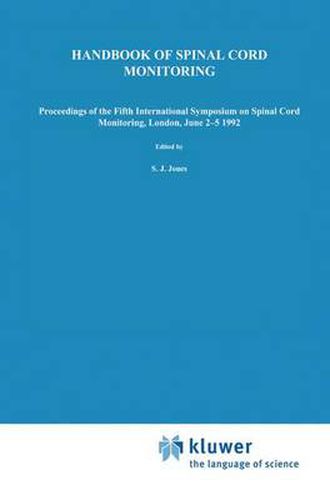Readings Newsletter
Become a Readings Member to make your shopping experience even easier.
Sign in or sign up for free!
You’re not far away from qualifying for FREE standard shipping within Australia
You’ve qualified for FREE standard shipping within Australia
The cart is loading…






This title is printed to order. This book may have been self-published. If so, we cannot guarantee the quality of the content. In the main most books will have gone through the editing process however some may not. We therefore suggest that you be aware of this before ordering this book. If in doubt check either the author or publisher’s details as we are unable to accept any returns unless they are faulty. Please contact us if you have any questions.
Surgery for the treatment of deformities such as scoliosis carries a small but significant risk of damage to the spinal cord through inadvertent compression or interference with the blood supply. Electrophysiological techniques, principally those for recording sensory and motor evoked potentials, offer a means of continuously assessing the conduction of nerve signals up and down the spinal cord and hence the possibility of detecting a defect at an early stage, when the cause may be reversible. This form of monitoring is now accepted practice in many countries.
The main contributors to the Handbook are surgeons, neurophysiologists and anaesthetists at the forefront of research. From the United States, where practice has been most widespread, come the results of the first large-scale, multi-centre survey into monitoring methods and their effectiveness. The research papers forming the remainder of the text provide an indication of the high level of current interest and the likely direction of future developments.
$9.00 standard shipping within Australia
FREE standard shipping within Australia for orders over $100.00
Express & International shipping calculated at checkout
This title is printed to order. This book may have been self-published. If so, we cannot guarantee the quality of the content. In the main most books will have gone through the editing process however some may not. We therefore suggest that you be aware of this before ordering this book. If in doubt check either the author or publisher’s details as we are unable to accept any returns unless they are faulty. Please contact us if you have any questions.
Surgery for the treatment of deformities such as scoliosis carries a small but significant risk of damage to the spinal cord through inadvertent compression or interference with the blood supply. Electrophysiological techniques, principally those for recording sensory and motor evoked potentials, offer a means of continuously assessing the conduction of nerve signals up and down the spinal cord and hence the possibility of detecting a defect at an early stage, when the cause may be reversible. This form of monitoring is now accepted practice in many countries.
The main contributors to the Handbook are surgeons, neurophysiologists and anaesthetists at the forefront of research. From the United States, where practice has been most widespread, come the results of the first large-scale, multi-centre survey into monitoring methods and their effectiveness. The research papers forming the remainder of the text provide an indication of the high level of current interest and the likely direction of future developments.